| E-mail me at mcclainm@optonline.net | Visit my Facebook page | View my LinkedIn profile |
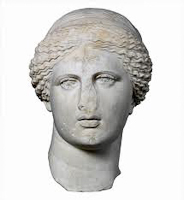
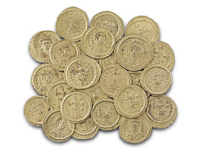 |
The appearance of reliquaries in the 4th century marked the rise of a particularly quirky era of fascination with the remains of martyrs. Workshops near local shrines sold little flasks of oil into which relics had been dipped, giving them mystical powers. One ampulla in the exhibition bears an image of St. Thekla, an early follower of St. Paul, who survived repeated exposures to wild beasts. She is shown with lions licking her feet. Another portrays St. Simeon, who spent 37 years atop a pillar performing prodigious feats of self-denial.
A marble bust of Aphrodite with a Christian cross chiseled into her forehead and her eyes, nose and mouth defaced (see above) set me to wondering why Christians felt the need to destroy ancient Greek artifacts rather than preserve them. I was heartened to learn that a few Christians had a care for ancient culture. The brochure says: "Saint Augustine of Hippo tells us that his friend Marcellina, the sister of Bishop Ambrose of Milan, burned incense and kneeled in front of the images of Christ and the apostle Paul, along with those of Homer and Pythagoras."
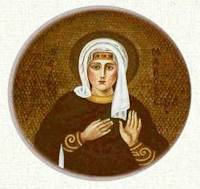 |
| St. Marcellina |
Marcellina belonged to a Gnostic sect headed by a man named Carpocrates who taught that the key to getting into heaven was to engage in every form of life, even (or especially) those which are most forbidden. St. Irenaeus, writing about 180 AD, says that the activities of the Carpocratians were so scandalous that Christians should not even think about them, much less speak of them. 1
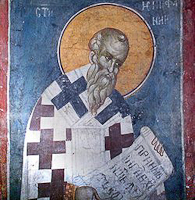 |
| Icon of St. Epiphanius |
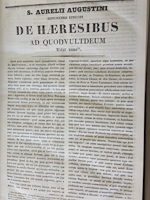 |
| De haeresibus |
All this mucking through anti-heretical tracts left me feeling slightly slimed but a bit closer to figuring out why someone took a hammer to the beautiful statue of Aphrodite. If Sts. Irenaeus, Epiphanius and Augustine could make such a fuss about burning incense before images of Jesus and the philosophers, what chance did an image of the pagan goddess have, especially one so capable of rousing erotic stirrings in young men who were supposed to be aspiring to 37 years on a pillar.
Feeling somewhat righteous myself, I sent a note to the Onassis Foundation, pointing out the error in their brochure and offering to provide them with references to the original sources. I got a very polite note back from Amalia Cosmetatou thanking me for visiting the exhibition and taking the time to bring the mistake to their attention. I only wish it had not been a mistake.
1 Irenaeus, Against the Heresies (Adversus haereses), Book I, chapter 25.
2 Epiphanius of Salamis, The Panarion, Book I, section 26. Translated by Frank Williams. Published as part of the Nag Hammadi Studies, 1987.
3 Irenaeus, ibid.
4 Epiphanius, Panarion, Anacephalaeosis II , 27, 2, p. 56.
5 Augustine, De haeresibus, Liber Unus, vii, in Migne, Patrologiae Latinae, 42.27.